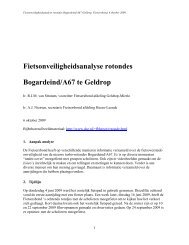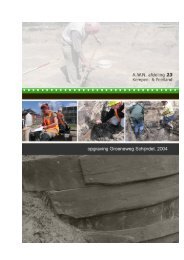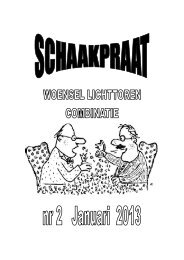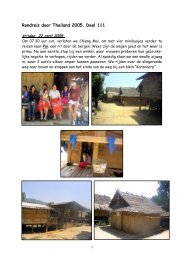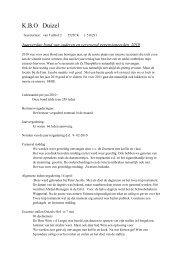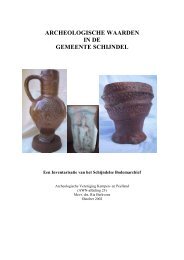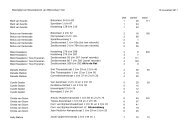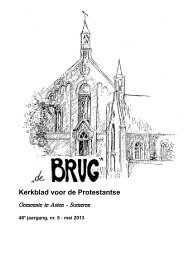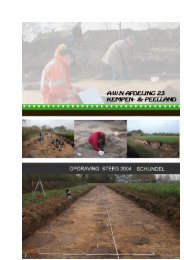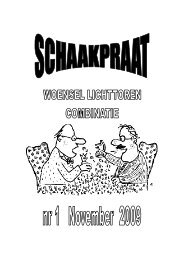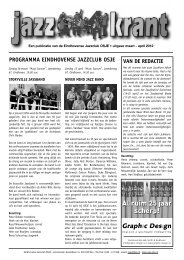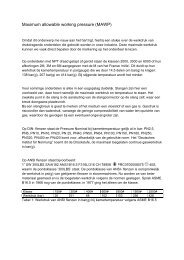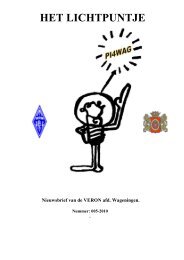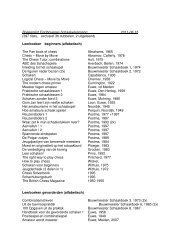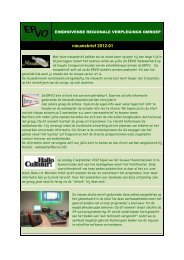Enriching Music with Synchronized Lyrics, Images and ... - CiteSeerX
Enriching Music with Synchronized Lyrics, Images and ... - CiteSeerX
Enriching Music with Synchronized Lyrics, Images and ... - CiteSeerX
You also want an ePaper? Increase the reach of your titles
YUMPU automatically turns print PDFs into web optimized ePapers that Google loves.
<strong>Enriching</strong> <strong>Music</strong> <strong>with</strong> <strong>Synchronized</strong><br />
<strong>Lyrics</strong>, <strong>Images</strong> <strong>and</strong> Colored Lights<br />
ABSTRACT<br />
We present a method to synchronize popular music <strong>with</strong> its lyrics<br />
at the stanza level. First we apply an algorithm to segment audio<br />
content into harmonically similar <strong>and</strong>/or contrasting progressions,<br />
i.e. the stanzas. We map the stanzas found to a sequence<br />
of labels, where stanzas <strong>with</strong> a similar progression are mapped to<br />
the same label. The lyrics are analyzed as well to compute a second<br />
sequence of labels. Using dynamic programming, an optimal<br />
match is found between the two sequences, resulting in a stanzalevel<br />
synchronization of the lyrics <strong>and</strong> the audio. The synchronized<br />
lyrics can be used to compute a synchronized slide show to accompany<br />
the music, where the images are retrieved using the lyrics.<br />
For an additional enrichment of the experience, colored light effects<br />
are synchronized <strong>with</strong> the music that are computed from the<br />
sets of images. The song segmentation can be done reliably, while<br />
the mapping of the audio segments <strong>and</strong> lyrics gives encouraging<br />
results.<br />
Categories <strong>and</strong> Subject Descriptors<br />
H.3.1 [Information Storage <strong>and</strong> Retrieval]: Content Analysis<br />
<strong>and</strong> Indexing; H.3.3 [Information Search <strong>and</strong> Retrieval]: Query<br />
formulation; H.5.5 [Information Interfaces <strong>and</strong> Presentation]:<br />
Sound <strong>and</strong> <strong>Music</strong> Computing<br />
General Terms<br />
Algorithms, Multimedia, Languages, Experimentation<br />
Keywords<br />
Ambience Creation, <strong>Lyrics</strong> Synchronization, Term Identification,<br />
Color extraction, <strong>Images</strong>, Search engines, World Wide Web<br />
1. INTRODUCTION<br />
Traditionally, cd-booklets contain the lyrics of the accompanying<br />
cd. <strong>Music</strong> distributed through the Internet however is not accompanied<br />
<strong>with</strong> its lyrics. The popularity of the large lyrics sites on the<br />
Ambi-Sys’08, February 11 - 14, 2008, Quebec, Canada.<br />
Gijs Geleijnse, Dragan Sekulovski, Jan Korst,<br />
Steffen Pauws, Bram Kater, Fabio Vignoli<br />
Philips Research<br />
High Tech Campus 34<br />
Eindhoven, the Netherl<strong>and</strong>s<br />
firstname.lastname@philips.com<br />
Web 1 underlines the interest of users in the lyrics of the music they<br />
listen to.<br />
In this work we present a method to synchronize music <strong>and</strong> lyrics<br />
at the stanza level. A synchronization on this level enables people<br />
to read along <strong>with</strong> the words <strong>and</strong> directly grasp the meaning of the<br />
text. Moreover, by coupling the lyrics to the music, people can<br />
easily browse through a song. For example, by selecting a chorus<br />
in the lyrics, a user can directly hear the chorus of the song.<br />
Light has been used only in conjunction <strong>with</strong> other media to enrich<br />
the media experience. From the disco lights <strong>with</strong> music, to<br />
the ambiLight TM television, light effects prove to enhance the experience.<br />
The effect is pronounced the most when the light effects<br />
are directly connected <strong>and</strong> time synchronized to the other media.<br />
Atmosphere creation <strong>with</strong> lighting however, is possible <strong>with</strong>out the<br />
media it was derived from. We do so by using an intermediate<br />
medium, i.e. the lyrics of the song.<br />
The features that are commonly used in atmosphere creation for<br />
music are low or mid level, for example volume, pitch, harmonic<br />
progression, etc. Using such features provides a good temporal<br />
correlation between the light effects <strong>and</strong> the music, but often fail<br />
to establish a semantic connection. In [8] a method is presented to<br />
enrich music <strong>with</strong> automatically computed light effects. The CIE<br />
[6, 22] lightness, chroma <strong>and</strong> hue of the light produced by light<br />
units is based on the volume, complexity of the sound <strong>and</strong> the pitch<br />
of the audio played. The results from the user study in [8] show<br />
that the users found the lightness <strong>and</strong> chroma well connected to the<br />
music. The hue of the lights, when automatically produced, was<br />
seen as arbitrary. The users preferred to change the hue manually<br />
to account for semantics in the music. It is clear that people perceive<br />
a semantic connection between hues <strong>and</strong> the music due to the<br />
lyrics. For example, when the Police sing Roxanne put on the red<br />
light one would also expect red light effects. When Wham’s joyful<br />
Club Tropicana is played, different colors are appropriate than<br />
when playing R.E.M.’s Everybody Hurts.<br />
Higher level semantics of the lyrics of the music play an important<br />
role of the color associated <strong>with</strong> the music. This inspired us to<br />
create a method to drive the color selection based on the lyrics.<br />
Work in [19] describes a method to compute a sequence of images<br />
<strong>and</strong> colored lights from a text. Terms <strong>with</strong>in the text are used to<br />
query a large image repository. The retrieved images are on the<br />
one h<strong>and</strong> presented in a slide show <strong>and</strong> on the other h<strong>and</strong> used to<br />
1 e.g. lyricsfreak.com, azlyrics.com
compute colors to be displayed through the colored lights.<br />
Using the lyrics synchronization at the stanza level, we can accomplish<br />
an approximate synchronization of colors <strong>and</strong> slide show <strong>with</strong><br />
the running of the audio of the music. Hence our aim is to accomplish<br />
an enjoyable additional experience while listening to music.<br />
Dependent on the occasion <strong>and</strong> the device, the music can be accompanied<br />
<strong>with</strong> its lyrics <strong>and</strong>/or images displayed on a screen <strong>and</strong><br />
colored lights.<br />
The contributions of this work are the following.<br />
− A novel lyrics synchronization algorithm at the stanza level is<br />
presented.<br />
− Using terms <strong>with</strong>in the lyrics, we present a method to automatically<br />
create a synchronized slide-show.<br />
− Computing the representative color from a set of images <strong>and</strong><br />
hence enabling to create synchronized meaningful light effects.<br />
This work is organized as follows. After having discussed related<br />
work in Section 2, we discuss the general outline of the lyrics synchronization<br />
method in Section 3. In Section 3.1 we discuss the<br />
segmentation of the audio, <strong>and</strong> in Section 3.2 the labelling of the<br />
lyrics. The method to align the two is presented in Section 3.3.<br />
Synchronizing music <strong>with</strong> relevant images <strong>and</strong> colors is presented<br />
in Section 4. Finally, experimental results are given in Section 6<br />
<strong>and</strong> we conclude in Section 7.<br />
2. RELATED WORK<br />
LyricAlly [21] is a system where music <strong>and</strong> lyrics are being aligned<br />
at the lyrics line level. However, the song structure of verse-chorusverse-chorus-bridge-outro<br />
is pre-assumed. This simplifies both the<br />
tasks of categorizing the audio <strong>and</strong> the lyrics. We present a more<br />
generalized lyrics synchronization method, where we discover both<br />
the structure of the audio <strong>and</strong> the lyrics before aligning the two.<br />
This work is continued in [7], where a synchronization on the syllable<br />
level is achieved using a dynamic programming table of the<br />
lyrics <strong>and</strong> the texts recognized by a speech recognizer. Contrary<br />
to our approach, this work is language dependent, as the speech<br />
recognizer needs to be trained for a specific language.<br />
Chen et al. [2] use singing voice detection [15] to segment music.<br />
The vocals <strong>with</strong>in the audio are processed by a speech recognizer.<br />
The output is then synchronized <strong>with</strong> the lyrics using forced alignment.<br />
Although the algorithm is evaluated only on six (Chinese)<br />
songs, the method is promising. However, it is currently unclear<br />
how the method performs on other music genres.<br />
In [20] Shamma et al. present <strong>Music</strong>Story, where they introduce the<br />
concept of music slide show creation <strong>and</strong> editing using lyrics. Our<br />
work differs from <strong>Music</strong>Story in a number of aspects. We scan the<br />
lyrics for terms rather than single words, leading to more relevant<br />
images. Moreover, in <strong>Music</strong>Story no synchronization of the images<br />
<strong>and</strong> lyrics is applied.<br />
The creation of light effects is to our best knowledge only addressed<br />
in [8]. In this work however, the colors were selected on audio<br />
features rather than on the lyrics.<br />
Earlier work on the retrieval of images relevant to music can be<br />
found in [18], where album covers are retrieved given an artist <strong>and</strong><br />
album title. We do not focus specifically on album covers, although<br />
album covers typically appear among the images when the title is<br />
one of the identified terms (e.g. Yellow Submarine).<br />
3. GLOBAL OUTLINE OF THE<br />
LYRICS SYNCHRONIZATION<br />
The stanza-level lyrics synchronization consists of three steps.<br />
1. We segment the audio into stanzas (i.e. verses, choruses, bridges<br />
<strong>and</strong> the like) by analyzing the harmonic progressions. We label<br />
each of the identified stanzas, assigning the same label to<br />
stanzas <strong>with</strong> a similar harmonic progression.<br />
2. We analyze the lyrics <strong>and</strong> label repeating stanzas as choruses,<br />
which are assigned <strong>with</strong> identical labels. To identify similar<br />
verses, we analyze the textual structure of the remaining<br />
stanzas. Two stanzas <strong>with</strong> similar structures are assigned the<br />
same label.<br />
3. Having computed two sequences of labels, we compute a<br />
best match between the two using a dynamic programming<br />
table.<br />
3.1 Identifying the structure of the audio<br />
We want to find a segmentation of the audio into compositional elements<br />
like intro, verse, chorus, bridge <strong>and</strong> outro. To this end, we<br />
capitalize on musicological observations in rock music [3] informing<br />
us, for instance, that verses contain similar harmonic progressions<br />
that can be different from a chorus progression. Also, bridges<br />
have a progression that is contrasting to all other sections in a song.<br />
The first music feature extraction step consists of identifying the<br />
beat period <strong>and</strong> the beat phase of the musical audio, similar to<br />
a technique described in [9]. This allows us to perform a beatsynchronous<br />
chroma vector analysis [17]. A chroma vector is a<br />
12-element vector that summarizes the spectral content around the<br />
frequencies that correspond <strong>with</strong> the twelve pitches in a chromatic<br />
scale over a range of octaves <strong>with</strong>in Western tonal music.<br />
We now have computed a sequence of chroma vectors O T 1 = o1,<br />
... , oT that can serve as a harmonic progression representation of<br />
musical audio. A preliminary problem definition is formulated as<br />
segmenting this vector sequence O T 1 into L consecutive segments<br />
that represent either similar, say repeated, or contrasting harmonic<br />
progressions. For simplicity, we assume the number of segments L<br />
to be known. A sensible number is the number of stanzas found in<br />
the lyrics analysis stage (Section 3.2).<br />
In order to measure the concept of two similar or two dissimilar<br />
chroma vectors, we use the cosine similarity measure s(t, k) between<br />
two vectors ot <strong>and</strong> ot+k at time index t <strong>and</strong> t + k <strong>and</strong> its<br />
versed version d(t, p), respectively,<br />
s(t, k) =<br />
ot · ot+k<br />
, (1)<br />
|ot||ot+k|<br />
d(t, p) = 1 − s(t, p). (2)<br />
To extend this concept to chroma vector sequences, we use the<br />
mean value of similarities between all pairs of chroma vectors, <strong>with</strong><br />
one vector from a given segment 0 ≤ l < L that extends from a
time index i to j <strong>and</strong> one vector that is a given number of time<br />
indices apart from the first one. In other words,<br />
S(i, j, ˆ 1<br />
Kl) =<br />
(j − i) | ˆ KL |<br />
j� �<br />
s(t, k). (3)<br />
t=i k∈ ˆ Kl where ˆ Kl is a set of time index differences (lags) between the<br />
chroma vectors in segment l <strong>and</strong> other parts in the chroma vector<br />
sequence. The set ˆ Kl is selected such that all time index differences<br />
result in maximally similar chroma vector sequences <strong>and</strong><br />
that all compared sequences are non-overlapping.<br />
Likewise, we also compute harmonically dissimilar sequences by<br />
comparing all chroma vectors in a given segment l <strong>and</strong> those that<br />
are ˆpl time indices apart. Thus,<br />
D(i, j, ˆpl) =<br />
1<br />
(j − i) 2<br />
j� j−i �<br />
d(t, ˆpl + q − t + i). (4)<br />
t=i q=0<br />
where ˆpl is the time index difference that provides the maximally<br />
dissimilar (i.e. contrasting) <strong>and</strong> non-overlapping chroma vector sequences.<br />
Finally, the problem can be formulated as finding the segment boundaries<br />
{b0, b1, ..., bL} by maximizing a linear combination of the<br />
harmonic similarities S(i, j, ˆ Kl) <strong>and</strong> harmonic contrasts D(i, j, ˆpl)<br />
over the complete chroma spectrum vector subsequence. This can<br />
be efficiently computed using a dynamic programming based on<br />
level building [14]. Additionally, at each iteration in building a single<br />
level, an optimization step is required to find the best ˆ Kl <strong>and</strong><br />
ˆpl. The details on the audio segmentation algorithm are provided<br />
elsewhere [16].<br />
By backtracking the optimal path in the dynamic programming table,<br />
one can easily find the segment boundaries {b0, b1, ..., bL}, but<br />
also the inter-segment similarities established by the linear combination<br />
of Equations 3 <strong>and</strong> 4, if they are stored in the table during the<br />
dynamic programming process. These inter-segment similarities<br />
are used in a clustering method based on singular value decomposition<br />
[4]. This allows us label the segments, resulting in sequences<br />
as “AABAABAABC”, which resembles a contrasting verse-chorus<br />
form in rock music ended by an outro or modulated end chorus [3].<br />
3.2 Identifying the structure of the lyrics<br />
We retrieve lyrics ls <strong>and</strong> assume that ls is a sound transcription of<br />
the song s. In this work, we consider the lyrics to be given, for<br />
work on automatic lyrics retrieval we refer to [10] <strong>and</strong> [5].<br />
We use the segmentation of ls in stanzas – depicted by blank lines<br />
– to identify the structure of ls [13]. To label each of the lyrics<br />
stanzas, we pose the following requirements.<br />
- Identical stanzas (typically relating to multiple occurrences<br />
of the chorus) should be assigned to the same label.<br />
- Stanzas that are textually different, but are similar in textual<br />
structure (i.e. the verses) should also be assigned to the same<br />
label.<br />
We first identify identical stanzas by determining the longest common<br />
subsequence (lcs) for each pair (i, k) of stanzas. We allow<br />
minor variations, hence the length of the lcs of i <strong>and</strong> k should approach<br />
both the length of i <strong>and</strong> k. Each of such repeating stanzas<br />
is assigned the same free label, say A.<br />
|i| − |lcs(i, k)| ≤ ɛ ∧ |k| − |lcs(i, k)| ≤ ɛ<br />
=⇒ l(i) = l(k) (5)<br />
Next we compare the structural properties of the remaining stanzas.<br />
We consider two stanzas to has a similar textual structure when<br />
they have the number of lines <strong>and</strong> number of syllables. Such stanzas<br />
may be verses <strong>with</strong> a similar harmonic progression in the audio.<br />
Structural similarity is based on determining for a given stanza the<br />
number of lines it contains <strong>and</strong> for each of these lines the number<br />
of syllables. For a given stanza i, let nl(i) denote the number of<br />
lines <strong>and</strong> let σ(i, j), <strong>with</strong> 1 ≤ j ≤ nl(i), denote the number of<br />
syllables in its j-th line. Now, we consider two stanzas i <strong>and</strong> k to<br />
be structurally identical as follows.<br />
<strong>with</strong><br />
for a given c.<br />
nl(i) = nl(k) ∧ ∀j(|σ(i, j) − σ(k, j)| ≤ u(i, j, k))<br />
=⇒ l(i) = l(k) (6)<br />
u(i, j, k) = c · max(s(i, j), s(k, j)) (7)<br />
In our experiments we used u(i, j, k) = 1. Note that for a given<br />
word, the number of syllables is not fixed, especially in music.<br />
Moreover, exceptions may occur where the syllable counting algorithm<br />
returns an erroneous number. We therefore allow differences<br />
between the numbers of syllables in the lines of the verses.<br />
Finally, the stanzas that are not similar to any other stanza are<br />
mapped to a free label.<br />
Computing the number of syllables<br />
Focussing on lyrics in English, we used a rule-based approach to<br />
estimate the number of syllables per word. An alternative would be<br />
to use a dictionary to look up the phonetic transcription of words<br />
where the division of syllables is displayed. However not all words<br />
can be found in such dictionaries, for example given names. Since<br />
we only need an estimation of the number of syllables per stanza,<br />
we opt for a rule-based approach.<br />
We implemented the algorithm proposed in [11]. Here, the basic<br />
idea is that each vowel can be associated <strong>with</strong> a syllable. A number<br />
of rules compensate for silent vowels (such as the u in query) or<br />
double vowels (such as ai in pair). The rule-based approach of<br />
syllable counting in [11] however does not cover every exception.<br />
To compensate for common words that are misinterpreted by the<br />
syllable counter, we use a small dictionary to look up the number<br />
of syllables of such exceptions.
3.3 Matching <strong>Lyrics</strong> <strong>and</strong> <strong>Music</strong><br />
We assume that lyrics stanzas are given as a sequence of labels,<br />
such as L = (ABABCAC), <strong>and</strong> similarly, that the audio segments<br />
are given as a sequence of labels, such as A = (AAACAC).<br />
For easy reference, the i-th label of L <strong>and</strong> A are called Li <strong>and</strong> Ai,<br />
respectively. Note that the number of labels in L <strong>and</strong> A need not<br />
be identical, for the following reasons. As audio segments may be<br />
instrumental, some Ak may not have a matching Li. Alternatively,<br />
it can be that multiple successive verses are not segmented in the<br />
audio domain. Also, in the lyrics transcription some blank lines<br />
may be missing, by which multiple stanzas appear as one. Hence,<br />
it may occur that |L| < |A| as well as |L| > |A|.<br />
To find a best match between both sequences, we aim to find a<br />
mapping m : {1, 2, . . . , |L|} → {1, 2, . . . , |A|} that maps each<br />
label in L to exactly one label in A. A mapping m is called feasible<br />
if it satisfies the following constraints.<br />
1. The mapping is order-preserving: for each pair<br />
i, j ∈ {1, 2, . . . , |L|} it holds that<br />
i < j =⇒ m(i) ≤ m(j).<br />
2. The mapping is consistent: for each pair i, j ∈<br />
{1, 2, . . . , |L|} it holds that<br />
Li = Lj =⇒ Am(i) = Am(j).<br />
Note that the definition of an order-preserving mapping allows that<br />
multiple lyrics stanzas are assigned to the same audio segment.<br />
For given sequences L <strong>and</strong> A, we can generate all feasible mappings<br />
using a depth-first tree search strategy. The search tree consists<br />
of multiple levels, where the edges that branch from a node on<br />
level i correspond to the possible assignments of the i-th label of<br />
L. An assignment made for a given node on the i-th level should be<br />
consistent <strong>with</strong> all assignments that are made on the path from the<br />
root-node to the given node. By definition, the resulting mappings<br />
will be order-preserving if m(i−1) ≤ m(i). If all generated edges<br />
satisfy both constraints, it is not difficult to see that all leaf-nodes<br />
on level |L| correspond to feasible mappings.<br />
The search tree will result in one of the following three situation:<br />
1. There is no feasible mapping found.<br />
2. There is exactly one feasible mapping found.<br />
3. There are multiple feasible mappings found.<br />
One feasible mapping. If there is exactly one feasible mapping<br />
found, then we consider that as the output of our algorithm.<br />
Multiple feasible mappings. If there are multiple mappings, then<br />
we consider the following reduction. Although not all audio segments<br />
need to correspond to a lyrics stanza, it is generally good<br />
if the range of m under L ( or equivalently the image of L) is of<br />
maximum cardinality. Consequently, if there are multiple feasible<br />
mappings then we restrict ourselves to the feasible mappings of<br />
which the range is of maximum cardinality. This usually gives a<br />
considerably reduction of the feasible mappings <strong>with</strong>out deleting<br />
the correct mapping.<br />
Figure 1: A screen shot of the lyrics synchronization application.<br />
By selecting a stanza <strong>with</strong>in the lyrics, the corresponding<br />
stanza is being played.<br />
Of the remaining solutions <strong>with</strong> maximum cardinality, we compute<br />
the ratio of the number of syllables <strong>and</strong> the duration of the assigned<br />
audio segment. By applying an upper bound for this ratio solutions<br />
<strong>with</strong> many syllables assigned to audio segments <strong>with</strong> a short duration,<br />
will hence be filtered out. From the remaining set of solutions,<br />
we select the one that minimizes the variance of ratios.<br />
No feasible mappings. If there is no feasible mapping found, then<br />
we look for a mapping that is still order-preserving, but we allow<br />
for a minimum number of inconsistencies. Given that there is no<br />
consistent, order-preserving mapping, we repeat the tree search,<br />
where we allow at most one assignment of an element from L to an<br />
element A that is inconsistent <strong>with</strong> earlier assignments (in the path<br />
from the root to the current node). Hence, in evaluating the search<br />
tree, we have to keep track of the partial mapping constructed so<br />
far as well as the number of inconsistencies that we allowed so far.<br />
If again no solution is found, then we can repeat the tree search<br />
allowing an additional inconsistency.<br />
In the experiments, we used 1 as the maximal number of inconsistencies.<br />
When no mapping can be found <strong>with</strong> one inconsistency,<br />
we used a fall back mechanism where the lyrics stanzas were assigned<br />
to the audio proportionally to the number of syllables <strong>with</strong>in<br />
the fragments. Hence, the audio segmentation is ignored when using<br />
the fall back mechanism.<br />
The synchronization of music <strong>and</strong> lyrics on the stanza level enables<br />
users to browse through music using the lyrics. For example, the<br />
user can easily skip through to the chorus or the bridge (see Figure<br />
1).<br />
4. IDENTIFYING IMAGES AND COLORS<br />
We are interested in the words in the lyrics that are the best c<strong>and</strong>idates<br />
to generate relevant images. As objects depicted in images<br />
can in general be described by noun phrases (e.g. little red corvette,<br />
crazy little thing called love, brown eyed girl) <strong>and</strong> proper nouns<br />
(e.g. Eindhoven, Prince Charles, Johnnie Walker), we focus on<br />
these groups of words <strong>with</strong>in the lyrics. We use these noun phrases
<strong>and</strong> proper nouns to query large image repositories 2 . The sizes of<br />
these image repositories enable querying these precise terms. Another<br />
benefit of querying noun phrases instead of single words is<br />
that it leads to disambiguation. For example the term wiley, windy<br />
Moors 3 reflects the moors in Yorkshire rather than the medieval<br />
Muslims in Iberia.<br />
We identify terms <strong>with</strong>in a text using a part of speech (PoS) tagger<br />
[1]. In this case we used QTag by Oliver Mason, since this package<br />
is provided <strong>with</strong> training data in English 4 . Since PoS taggers are<br />
typically trained on newspaper corpora, we first transform lyrics<br />
into somewhat more prosaic English. We consider each lyrics line<br />
as a sentence, so we capitalize the first letter <strong>and</strong> add punctuation<br />
marks where necessary. Then, we rewrite common slam <strong>and</strong> abbreviations.<br />
Hence, abbreviations like gonna <strong>and</strong> kinda are rewritten to<br />
going to <strong>and</strong> kind of. Words ending <strong>with</strong> in’ are rewritten to -ing,<br />
thus kiddin’ becomes kidding. Subsequently, we tag the adapted<br />
lyrics using QTag.<br />
The tags are used to identify noun phrases <strong>and</strong> proper nouns. We<br />
use a regular expression R to identify the longest sequences of<br />
words that may be noun phrases or proper nouns.<br />
R = (JJ + JJR + JJS) ∗ · (NN + NNS + NP + NPS) +<br />
Hence, we select the longest sequences of nouns possibly preceded<br />
by adjectives.<br />
We send each term <strong>with</strong>in the lyrics as a query to an image search<br />
engine. In our experiments we used both Flick.com <strong>and</strong> Google<br />
<strong>Images</strong> 5 , where we selected the option to only download full-color<br />
images. For each term we retrieve up to n images <strong>and</strong> store them in<br />
the order as they are presented by the search engine. However, if the<br />
number of images found using a multi-word term does not surpass<br />
a threshold n, we broaden the query by removing the first words.<br />
For example, little red corvette can be broadened by querying first<br />
red corvette <strong>and</strong> consequently corvette. We remove duplicates by<br />
comparing the URLs of the images.<br />
We have now obtained an annotated lyrics file, where each term is<br />
annotated <strong>with</strong> a list of at most n images.<br />
After we have collected a set of images for term t, we identify the<br />
most representative color for this term using the images. The definition<br />
of a representative color is highly dependent on the context in<br />
which the extraction is done. The importance of an exact definition<br />
is diminished in our work because we extract a set of representative<br />
colors rather than one representative color. Most prior work on representative<br />
color extraction for single images uses the mean or the<br />
mode of the color distribution in an image, or a representative from<br />
a coherent part of the image after image color segmentation, as an<br />
estimate for the representative color. Prior work also describes use<br />
of perceptual effects like simultaneous color contrast as part of the<br />
representative color extraction.<br />
We define a color to be in the set of representative colors if it is a lo-<br />
2 flickr.com, images.google.com<br />
3 Taken from Wuthering Heights by Kate Bush.<br />
4 www.english.bham.ac.uk/staff/omason/software/qtag.html<br />
5 http://flickr.com <strong>and</strong> http://images.google.com<br />
cal maximum in the density, i.e. the local mode, of the distribution<br />
of colors found in an image or set of images <strong>and</strong> has a corrected<br />
frequency above a certain threshold.<br />
The extraction is done in two stages. First, for each of the images in<br />
It, the representative colors are extracted. This is the set of colors<br />
which have a count larger than a threshold (the histogram method)<br />
or the set of local maxima <strong>with</strong> a small granularity (the mean shift<br />
method). In the case of extracting local maxima, we keep only the<br />
maxima that have a large enough contribution for the region they<br />
represent. The first step is done for two reasons: To take into account<br />
only the presence of a color, <strong>and</strong> not the relative contribution,<br />
something that in our experience would bias the distribution in the<br />
color set for all images even more; To account for the colors that<br />
are present only as noise.<br />
Second, using the color set built previously, the overall set distribution<br />
is computed for all of the images in It. The distribution<br />
is then corrected to account for the non-uniformity of the distribution<br />
of colors in the set of all possible images (of which we build<br />
an estimate). After the correction, the set of representative colors<br />
is extracted by finding the local maxima of the distribution <strong>with</strong> a<br />
given granularity. The exact details depend on the algorithm that is<br />
selected. Beside extraction of the set, we also compute a relative<br />
contribution measure for every color in the set <strong>and</strong> filter the colors<br />
that have a significantly lower contribution than the one <strong>with</strong> the<br />
highest contribution in the set.<br />
This phase resolves in an annotated lyrics file, where each term is<br />
annotated <strong>with</strong> a list of at most n images <strong>and</strong> a representative color<br />
expressed in RGB values.<br />
5. SYNCHRONIZING IMAGES AND COL-<br />
ORS WITH THE MUSIC<br />
The length of the stanzas is now expressed both in seconds <strong>and</strong><br />
in the number of syllables. These parameters are used to estimate<br />
the moment the terms identified are being sung in the music. We<br />
assume that the syllables sung in the lyrics are of equal length in<br />
seconds. Hence, suppose a stanza has a length of s seconds <strong>and</strong><br />
contains n syllables. Then the term starting at syllable m is as-<br />
seconds after the start of the stanza.<br />
sumed to be sung at s·m<br />
n<br />
For the non-vocal stanzas, we display images <strong>and</strong> lights generated<br />
by querying both the name of the performing artist <strong>and</strong> the title of<br />
the song.<br />
To enhance a relaxed, undisturbing atmosphere, we create smooth<br />
transitions of the colors.<br />
6. EXPERIMENTAL RESULTS<br />
As the main purpose of this work is to explore the technical feasibility<br />
of the system, we measure the performance of our algorithms<br />
in a number of separate aspects. In the next subsection, we focus on<br />
the evaluation of the audio segmentation. Section 6.2 h<strong>and</strong>les the<br />
evaluation of the synchronization, while in Section 6.3 we focus on<br />
the computation of a representative color for a given term.<br />
6.1 Segmenting the audio<br />
We evaluate the audio segmentation on a ground truth collection<br />
of 60 manually segmented rock songs. We use two measures to<br />
evaluate the audio segmentation: accuracy assesses the locations of<br />
the computed boundaries <strong>and</strong> precision/recall to describe the degree
match/mismatch of the computed segments <strong>and</strong> the ground truth<br />
boundaries.<br />
The accuracy of the audio segmentation on the 60 rock songs shows<br />
to be 80% <strong>with</strong>in 4 beats, i.e. one musical measure, from both sides<br />
of the ground truth boundary. The accuracy is still 50% <strong>with</strong>in two<br />
beats. The algorithm does not return completely wrong segmentation<br />
results as the accuracy increases rapidly towards full coverage.<br />
The mean precision (focussing on the number of false boundaries)<br />
<strong>and</strong> recall (focussing on the missed boundaries) are 0.94 <strong>and</strong> 0.86<br />
respectively for the set of 60 songs. For further details we refer to<br />
[16].<br />
Hence, we conclude that the segmentation is robust enough for the<br />
intended application. In a semi-automatic setting, where computed<br />
results are manually fine-tuned, the algorithm can be of valuable<br />
assistance.<br />
6.2 Aligning lyrics <strong>and</strong> audio<br />
To evaluate the stanza-level lyrics synchronization algorithm, we<br />
applied it on 58 rock/pop songs. In order to properly evaluate the<br />
synchronization algorithm, the audio for these songs was manually<br />
segmented <strong>and</strong> labeled. We hence assume the audio segmentation<br />
<strong>and</strong> labeling to be correct. The lyrics were acquired from a lyrics<br />
site, where the partitioning in stanzas is assumed to be defined by<br />
the separating blank lines. The lyrics stanzas are automatically labeled<br />
<strong>and</strong> the number of syllables per line is automatically determined,<br />
as discussed in Section 3.2.<br />
Giving these input data a mapping of lyrics stanzas to audio segments<br />
was constructed for each of the songs. Of all the 2157 lines<br />
appearing in these 58 songs, 1721 lines are assigned to the correct<br />
audio segment, i.e., to the audio segment in which the line is actually<br />
being sung. This means that 80% of the lines were assigned<br />
correctly.<br />
Some of the errors that are still being made relate to the uncertainty<br />
between vocal <strong>and</strong> non-vocal audio segments. Others relate<br />
to situations where the heuristic is used to choose between multiple<br />
feasible mappings the one that results in the smallest variance in<br />
(number of syllables)/duration ratio.<br />
The experimental results using the simple synchronization algorithm<br />
are encouraging. However, as a correct synchronization is<br />
crucial for linking terms, images <strong>and</strong> colors to the music, the current<br />
algorithm can be seen as an assistant for semi-automatic lyrics<br />
synchronization.<br />
6.3 Identifying Colors for a Term<br />
Given a term, we are interested whether the computed color is<br />
likely to be associated <strong>with</strong> the term.<br />
In the first part of the experiment, we evaluate the computed colors<br />
for color terms like red <strong>and</strong> blue <strong>and</strong> compare the results <strong>with</strong><br />
the same terms in a different language, Finnish. We expect these<br />
different terms, which lead to different sets of images, to generate<br />
similar colors.<br />
In the second experiment on color computations, we compare the<br />
results using two different sources for the images: the social image<br />
site Flickr.com <strong>and</strong> the content found <strong>with</strong> Google <strong>Images</strong>.<br />
Color names<br />
To subjectively assess the performance of the method, we present<br />
the colors which were computed as most relevant for a number of<br />
color names in English <strong>and</strong> Finnish in Table 1 <strong>and</strong> Figure 2. The<br />
presented results use the histogram method <strong>with</strong> 16 bins per channel<br />
<strong>and</strong> images from both Google <strong>and</strong> Flickr <strong>with</strong> a set of around<br />
200 images for each image search engine.<br />
The colors <strong>with</strong> high expected chroma (blue, yellow, red, green,<br />
brown <strong>and</strong> orange) have also a high computed chroma value. Furthermore,<br />
the hue difference between the colors for the English <strong>and</strong><br />
the Finnish terms is small. Visual inspection also shows that the<br />
results are acceptable as representatives of the colors which names<br />
are used in the method.<br />
The colors <strong>with</strong> lower expected chroma (black, white <strong>and</strong> gray)<br />
have a chroma value in all cases smaller than the chroma values<br />
for the first group. The difference between the colors for the color<br />
names in English <strong>and</strong> Finnish is also bigger in this case. Note that<br />
for very low chroma values, the hue value is undefined. For each of<br />
the colors in this group, at least one of the colors is not acceptable<br />
as a representative for the color <strong>with</strong> the name used in the method.<br />
It has to be noted that in each of the cases, one of the other colors<br />
in the representative set was acceptable as a representative color.<br />
Lightness Chroma Hue<br />
blue 27 59 280<br />
sininen 38 38 282<br />
yellow 74 63 94<br />
keltainen 83 73 83<br />
red 35 55 31<br />
punainen 41 68 33<br />
black 16 0. 315<br />
musta 68 0. 315<br />
white 63 17 286<br />
valkoinen 87 6 19<br />
green 53 28 130<br />
vihreä 45 39 132<br />
brown 48 25 43<br />
ruskea 65 23 67<br />
gray 75 11 69<br />
harmaa 74 0. 315<br />
orange 68 76 59<br />
oranssi 57 69 52<br />
Table 1: Most representative colors for the color names in English<br />
<strong>and</strong> Finnish. The colors are given in the CIE Lch color<br />
space.<br />
To give a more objective assessment on the performance of the<br />
method <strong>and</strong> to give a basis for an automatic evaluation we used the<br />
results in [12], which give the acceptable range of CIE Lch hues for<br />
the colors blue, red, green <strong>and</strong> yellow. Table 2 gives an overview<br />
of the selected colors <strong>with</strong> the range of hue angles that correspond<br />
to each color. The hues for the most representative colors shown<br />
in Table 1 fall into the boundaries defined in Table 2. Furthermore,<br />
applying both the histogram <strong>with</strong> 8, 16 <strong>and</strong> 32 bins per channel <strong>and</strong>
Figure 2: Most representative colors for nine color names in<br />
Table1 in English <strong>and</strong> Finnish.<br />
the mean shift algorithm produced most representative colors <strong>with</strong><br />
hues that fall into the boundaries given in Table 2. Taking only the<br />
images which were in the set of search results of one of the image<br />
search engines, either Google or Flickr, also produced results <strong>with</strong><br />
hues inside the given boundaries.<br />
Minimum h Focal h Maximum h<br />
red 350 24 41<br />
yellow 75 87 101<br />
green 112 175 222<br />
blue 223 246 287<br />
Table 2: Hue angles for color regions.<br />
Search engine influence<br />
Previous results presented take images from both image search engines.<br />
It is interesting to look at possible differences between the<br />
engines, specially because they use two different kinds of indexing.<br />
We expect that Flickr, which has manual tagging would overall perform<br />
better. To present the differences we use the KL divergence.<br />
The expectation that Flickr will provide better results can be translated<br />
to an expectation of a higher divergence for the distribution<br />
computed from the set of images acquired from Flickr.<br />
The distributions computed from the images acquired from Flickr<br />
had a mean divergence of 0.1769 <strong>with</strong> a variance of 0.1172. The<br />
Google based ones had a mean of 0.1315 <strong>and</strong> a variance of 0.0604.<br />
A paired t-test on the divergence values showed a significant effect<br />
at α = 0.05.<br />
On closer inspection of the data, we observed that the large variance<br />
in the Flickr data was due to a small number of terms (10<br />
from the 60) which had a much higher divergence value than the<br />
others. The terms <strong>with</strong> this property were all in Finnish <strong>and</strong> the<br />
number of images acquired less than 50. On the other h<strong>and</strong>, all the<br />
Google image sets had 200 images, which was the limit used in the<br />
experiments. After these terms are filtered, the divergence distribution<br />
for the Google had a change of mean to the values of 0.1286<br />
<strong>with</strong> a st<strong>and</strong>ard deviation of 0.0521. The new mean divergence for<br />
the Flickr set was 0.1325 <strong>with</strong> a st<strong>and</strong>ard deviation of 0.753. While<br />
the Google mean divergence changed 2.2%, the Flickr one changed<br />
25%. A repeated paired t-test for equality of means showed no significant<br />
effect of the search engine at α = 0.05.<br />
Figure 3 shows the divergence values for the distributions com-<br />
puted from the images acquired from Google <strong>and</strong> Flickr.<br />
The above results show that contrary to our prior belief, for the set<br />
of terms we used we did not find a significant effect of the search<br />
engine used on the suitability of the produced image sets for representative<br />
color extraction. The number of images in the set, however,<br />
showed a significant effect.<br />
Divergence<br />
0.35<br />
0.3<br />
0.25<br />
0.2<br />
0.15<br />
0.1<br />
0.05<br />
Flickr<br />
Google<br />
0<br />
0 5 10 15 20 25 30<br />
Term<br />
Figure 3: Divergence for images sets from different search engines.<br />
7. CONCLUSIONS AND FUTURE WORK<br />
We presented a method to enrich music <strong>with</strong> synchronized lyrics,<br />
images <strong>and</strong> colored lights. We automatically synchronize the lyrics<br />
at the stanza level, providing easy access to the text of the song.<br />
As the results of the synchronization are promising, this work provides<br />
possibilities to enrich music <strong>with</strong> synchronized effects such<br />
as images <strong>and</strong> colors. With or <strong>with</strong>out the retrieved images, the use<br />
of colored lights <strong>with</strong> music may be a promising new multimedia<br />
concept in the living room. The colors are computed based on the<br />
representative color associated <strong>with</strong> the terms in the lyrics. Hence,<br />
the colors are meaningful when it matters <strong>and</strong> are an enjoyable experience<br />
otherwise.<br />
Experimental results from studies in audio segmentation, lyrics synchronization<br />
<strong>and</strong> color identification are promising. However, the<br />
system described in this work is open to further improvements. We<br />
mention the following issues for future work.<br />
<strong>Lyrics</strong> Selection. Currently, we segment the lyrics of the song using<br />
blank lines. However, when we search for lyrics on the web,<br />
multiple versions – <strong>and</strong> multiple segmentations – may be found<br />
[10, 5]. Hence, in future work we plan to compute the most likely<br />
segmentation of the lyrics instead of manually selecting a wellsegmented<br />
version.<br />
Stanza-level <strong>Lyrics</strong> Synchronization. We currently assume the<br />
number of segments L in the audio to be given. In future work,<br />
we want to find the best possible L for segmenting the audio, the<br />
number of lyrics can be used to approximate this. Singing voice<br />
detection is helpful when mapping lyrics to audio fragments, as we<br />
currently cannot discriminate between vocal <strong>and</strong> non-vocal fragments.<br />
Towards Fine-grained <strong>Lyrics</strong> Synchronization. As indicated in<br />
Section 2, recently [7, 2], work is done on a more fine-grained synchronization<br />
of lyrics <strong>and</strong> audio. We plan to investigate whether the
use of these methods is suitable for western popular music. A reliable<br />
synchronization on the syllable level will improve the timing<br />
of the images <strong>and</strong> colors as well.<br />
Language Dependencies. The syllable counting algorithm as described<br />
in Section 3.2 is created for the English language. Alike the<br />
approaches in [7] <strong>and</strong> [2] our method is thus language dependent.<br />
Alternatives to the current syllable counting algorithm need to be<br />
found to solve this problem.<br />
User Evaluation. The results of this work show that we can automatically<br />
or semi-automatically create a synchronized atmosphere<br />
using the lyrics of the song being played. In future work, a number<br />
of open questions are to be resolved by user experiments.<br />
- Perception of the slide show. How do users experience the<br />
slide show? We currently select a fixed number of terms per<br />
stanza, but this might not be optimal. The tempo of the song<br />
might effect the best appreciated pace for the slide show.<br />
Moreover, we can vary on the number images to display.<br />
- Perception of the colored lights. Do the users appreciate<br />
the connection of the lights to the lyrics? It is interesting<br />
to find out whether users recognize the connection between<br />
lyrics <strong>and</strong> light effects, <strong>with</strong>out the images displayed.<br />
- Overall perception. How is the overall user experience?<br />
User test need to point out whether the lights <strong>and</strong> images<br />
indeed enrich the listening experience.<br />
8. REFERENCES<br />
[1] E. Brill. A simple rule-based part-of-speech tagger. In<br />
Proceedings of the third Conference on Applied Natural<br />
Language Processing (ANLP’92), pages 152 – 155, Trento,<br />
Italy, 1992.<br />
[2] K. Chen, S. Gao, Y. Zhu, <strong>and</strong> Q. Sun. Popular song <strong>and</strong><br />
lyrics synchronization <strong>and</strong> its application to music<br />
information retrieval. In Proceedings of the Thirteenth<br />
Annual Multimedia Computing <strong>and</strong> Networking Conference<br />
2006, San Jose, CA, January 2006.<br />
[3] J. Covach. Form in rock music. In D. Stein, editor, Engaging<br />
<strong>Music</strong>: Essays in <strong>Music</strong> Analysis, pages 65 – 76. 2005.<br />
[4] J. Foote <strong>and</strong> M. Cooper. Media segmentation using<br />
self-similarity decomposition. In Proceedings of SPIE<br />
Storage <strong>and</strong> Retrieval for Multimedia Databases, pages 167<br />
– 175, 2003.<br />
[5] G. Geleijnse <strong>and</strong> J. Korst. Efficient lyrics extraction from the<br />
web. In R. Dannenberg, K. Lemström, <strong>and</strong> A. Tindale,<br />
editors, Proceedings of the Seventh International Conference<br />
on <strong>Music</strong> Information Retrieval (ISMIR’06), pages 371 –<br />
372, Victoria, Canada, 2006. University of Victoria.<br />
[6] International Commission on Illumination (CIE). website:<br />
http://www.cie.co.at/cie/.<br />
[7] D. Isk<strong>and</strong>er, Y. Wang, M.-Y. Kan, <strong>and</strong> H. Li. Syllabic level<br />
automatic synchronization of music signals <strong>and</strong> text lyrics. In<br />
MULTIMEDIA ’06: Proceedings of the 14th annual ACM<br />
international conference on Multimedia, pages 659 – 662,<br />
Santa Barbara, CA, 2006.<br />
[8] B. Kater. <strong>Music</strong> based light effects. Master’s thesis,<br />
Eindhoven University of Technology, 2005.<br />
[9] A. Klapuri, A. Eronen, <strong>and</strong> J. Astola. Analysis of the meter<br />
of acoustic musical signals. IEEE Transactions on Audio,<br />
Speech, <strong>and</strong> Language Processing, 14(1):342 – 355, 2006.<br />
[10] P. Knees, M. Schedl, <strong>and</strong> G. Widmer. Multiple <strong>Lyrics</strong><br />
Alignment: Automatic Retrieval of Song <strong>Lyrics</strong>. In<br />
Proceedings of 6th International Conference on <strong>Music</strong><br />
Information Retrieval (ISMIR’05), pages 564 – 569, London,<br />
UK, September 2005.<br />
[11] H. Kucera, R. Sokolowski, <strong>and</strong> J. Rossum. Method <strong>and</strong><br />
apparatus for text analysis, 1986. US Patent no. 4,773,009.<br />
[12] R. G. Kuehni. Focal color variability <strong>and</strong> unique hue<br />
stimulus variability. Journal of Cognition <strong>and</strong> Culture,<br />
5(18):409–426, 2005.<br />
[13] J. P. G. Mahedero, Álvaro Martínez, P. Cano,<br />
M. Koppenberger, <strong>and</strong> F. Gouyon. Natural language<br />
processing of lyrics. In MULTIMEDIA ’05: Proceedings of<br />
the 13th annual ACM international conference on<br />
Multimedia, pages 475 – 478, New York, NY, USA, 2005.<br />
ACM Press.<br />
[14] C. Myers <strong>and</strong> L. Rabiner. A level building dynamic time<br />
warping algorithm for connected word recognition. IEEE<br />
Trans. on Acoustics, Speech <strong>and</strong> Signal Processing,<br />
ASSP-29(2):284 – 297, 1981.<br />
[15] T. L. Nwe, A. Shenoy, <strong>and</strong> Y. Wang. Singing voice detection<br />
in popular music. In MULTIMEDIA ’04: Proceedings of the<br />
12th annual ACM international conference on Multimedia,<br />
pages 324–327, New York, NY, USA, 2004. ACM Press.<br />
[16] S. Pauws. Automatically discovering structure in popular<br />
music. In W. Verhaegh, E. Aarts, W. ten Kate, J. Korst, <strong>and</strong><br />
S. Pauws, editors, Proceedings Third Philips Symposium on<br />
Intelligent Algorithms (SOIA 2006), pages 73 – 84,<br />
Eindhoven, the Netherl<strong>and</strong>s, December 2006.<br />
[17] S. Pauws. Extracting the key from music. In Intelligent<br />
Algorithms in Ambient <strong>and</strong> Biomedical Computing, Philips<br />
Research Book Series, pages 119 – 132. Springer, 2006.<br />
[18] M. Schedl, P. Knees, T. Pohle, <strong>and</strong> G. Widmer. Towards<br />
Automatic Retrieval of Album Covers. In Proceedings of the<br />
28th European Conference on Information Retrieval<br />
(ECIR’06), London, UK, April 2006.<br />
[19] D. Sekulovski, G. Geleijnse, B. Kater, J. Korst, S. Pauws,<br />
<strong>and</strong> R. Clout. <strong>Enriching</strong> text <strong>with</strong> images <strong>and</strong> colored light.<br />
In Proceedings of the IS&T/SPIE 20th Annual Electronic<br />
Imaging Symposium, San Jose, CA, 2008.<br />
[20] D. A. Shamma, B. Pardo, <strong>and</strong> K. J. Hammond. <strong>Music</strong>story: a<br />
personalized music video creator. In MULTIMEDIA ’05:<br />
Proceedings of the 13th annual ACM international<br />
conference on Multimedia, pages 563 – 566, Singapore,<br />
2005.<br />
[21] Y. Wang, M.-Y. Kan, T. L. Nwe, A. Shenoy, <strong>and</strong> J. Yin.<br />
Lyrically: automatic synchronization of acoustic musical<br />
signals <strong>and</strong> textual lyrics. In MULTIMEDIA ’04:<br />
Proceedings of the 12th annual ACM international<br />
conference on Multimedia, pages 212 – 219, New York, NY,<br />
2004.<br />
[22] G. Wyszecki <strong>and</strong> W. S. Styles. Color Science: Concepts <strong>and</strong><br />
Methods, Quantitative Data <strong>and</strong> Formulae (2nd ed.). John<br />
Wiley <strong>and</strong> Sons, Inc., New York, NY, 1982.



